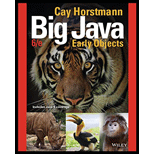
Big Java, Binder Ready Version: Early Objects
6th Edition
ISBN: 9781119056447
Author: Cay S. Horstmann
Publisher: WILEY
expand_more
expand_more
format_list_bulleted
Question
Chapter 25, Problem 1RE
Program Plan Intro
Hypertext Markup Language (HTML):
- It is one of the markup languages that is used to format web documents.
- It contains opening and closing tags that tells the browser how to organize the text, headings, body, title, and so on.
- HTML contains codes that are placed in a file in order to display on a browser.
- The web browser renders the code in HTML file and it displays the page and its associated files.
XML - Extensible Markup Language
- XML is a language that contains a collection of rules used for encoding the content of a document in a format (human-readable and machine-readable).
- It is used to carry the content of any document.
- The tags are not predefined; and so the programmers can create their own set of tags to describe the data used in the document.
- The elements should have the start tag and its matching end-tag.
- XML is a metalanguage which was established by World Wide Web Consortium.
- It is an extended version of SGML (Standard Generalized Markup Language) that is used to describe more markup languages.
- The DTD describes the structure of a particular XML document.
- The Document Type Definition (DTD) is an organization specification of an XML document.
- The filename extension is “.xml”.
Syntax:
<root>
<child>
<subchild>........</subchild>
</child></root>
Expert Solution & Answer
Explanation of Solution
Similarities of HTML and XML:
- Both HTML and XML are markup languages.
- Both HTML and XML are extended versions of Standard Generalized Markup Language (SGML).
- Both uses tags in order to describe the content.
Differences between HTML and XML:
| HTML | XML |
| The full form is Hypertext Markup Language | The full form is Extensible markup language. |
| It does not contain structural information. | It contains structural information. |
| Whitespaces are not preserved. | Whitespaces are preserved. |
| It is case insensitive | It is case sensitive |
| It is format driven. | It is content drive. |
Examples:
HTML: "<li>" is same as "<LI>"
XML: "<LI>" is not the same as "<li>" // case sensitive
HTML: <img src="hamster.jpeg">
XML: <img src="hamster.jpeg"/> // must provide end-tag
HTML: <img src="hamster.jpeg" width=400 height=300>
XML: <img src="hamster.jpeg" width="400" height="300"/>
// quote attribute values
Want to see more full solutions like this?
Subscribe now to access step-by-step solutions to millions of textbook problems written by subject matter experts!
Chapter 25 Solutions
Big Java, Binder Ready Version: Early Objects
Ch. 25.1 - Prob. 1SCCh. 25.1 - Prob. 2SCCh. 25.1 - Prob. 3SCCh. 25.2 - Prob. 4SCCh. 25.2 - Prob. 5SCCh. 25.3 - Prob. 6SCCh. 25.3 - Prob. 7SCCh. 25.4 - Prob. 8SCCh. 25.4 - Prob. 9SCCh. 25.4 - Prob. 10SC
Ch. 25 - Prob. 1RECh. 25 - Prob. 2RECh. 25 - Prob. 3RECh. 25 - Prob. 4RECh. 25 - Prob. 5RECh. 25 - Prob. 6RECh. 25 - Prob. 7RECh. 25 - Prob. 8RECh. 25 - Prob. 9RECh. 25 - Prob. 10RECh. 25 - Prob. 11RECh. 25 - Prob. 12RECh. 25 - Prob. 13RECh. 25 - Prob. 14RECh. 25 - Prob. 15RECh. 25 - Prob. 16RECh. 25 - Prob. 17RECh. 25 - Prob. 18RECh. 25 - Prob. 1PECh. 25 - Prob. 2PECh. 25 - Prob. 3PECh. 25 - Prob. 4PECh. 25 - Prob. 5PECh. 25 - Prob. 6PECh. 25 - Prob. 1PPCh. 25 - Prob. 2PPCh. 25 - Prob. 3PPCh. 25 - Prob. 4PPCh. 25 - Prob. 5PPCh. 25 - Prob. 6PPCh. 25 - Prob. 7PPCh. 25 - Prob. 8PPCh. 25 - Prob. 9PPCh. 25 - Prob. 10PPCh. 25 - Prob. 11PPCh. 25 - Prob. 12PP
Knowledge Booster
Recommended textbooks for you
 Database System ConceptsComputer ScienceISBN:9780078022159Author:Abraham Silberschatz Professor, Henry F. Korth, S. SudarshanPublisher:McGraw-Hill Education
Database System ConceptsComputer ScienceISBN:9780078022159Author:Abraham Silberschatz Professor, Henry F. Korth, S. SudarshanPublisher:McGraw-Hill Education Starting Out with Python (4th Edition)Computer ScienceISBN:9780134444321Author:Tony GaddisPublisher:PEARSON
Starting Out with Python (4th Edition)Computer ScienceISBN:9780134444321Author:Tony GaddisPublisher:PEARSON Digital Fundamentals (11th Edition)Computer ScienceISBN:9780132737968Author:Thomas L. FloydPublisher:PEARSON
Digital Fundamentals (11th Edition)Computer ScienceISBN:9780132737968Author:Thomas L. FloydPublisher:PEARSON C How to Program (8th Edition)Computer ScienceISBN:9780133976892Author:Paul J. Deitel, Harvey DeitelPublisher:PEARSON
C How to Program (8th Edition)Computer ScienceISBN:9780133976892Author:Paul J. Deitel, Harvey DeitelPublisher:PEARSON Database Systems: Design, Implementation, & Manag...Computer ScienceISBN:9781337627900Author:Carlos Coronel, Steven MorrisPublisher:Cengage Learning
Database Systems: Design, Implementation, & Manag...Computer ScienceISBN:9781337627900Author:Carlos Coronel, Steven MorrisPublisher:Cengage Learning Programmable Logic ControllersComputer ScienceISBN:9780073373843Author:Frank D. PetruzellaPublisher:McGraw-Hill Education
Programmable Logic ControllersComputer ScienceISBN:9780073373843Author:Frank D. PetruzellaPublisher:McGraw-Hill Education

Database System Concepts
Computer Science
ISBN:9780078022159
Author:Abraham Silberschatz Professor, Henry F. Korth, S. Sudarshan
Publisher:McGraw-Hill Education

Starting Out with Python (4th Edition)
Computer Science
ISBN:9780134444321
Author:Tony Gaddis
Publisher:PEARSON

Digital Fundamentals (11th Edition)
Computer Science
ISBN:9780132737968
Author:Thomas L. Floyd
Publisher:PEARSON

C How to Program (8th Edition)
Computer Science
ISBN:9780133976892
Author:Paul J. Deitel, Harvey Deitel
Publisher:PEARSON

Database Systems: Design, Implementation, & Manag...
Computer Science
ISBN:9781337627900
Author:Carlos Coronel, Steven Morris
Publisher:Cengage Learning

Programmable Logic Controllers
Computer Science
ISBN:9780073373843
Author:Frank D. Petruzella
Publisher:McGraw-Hill Education